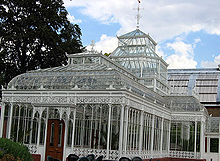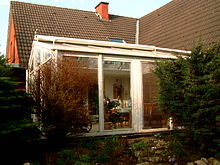- Conservatory (greenhouse)
-
For conservatories of musical education, see music school.
 A traditional conservatory at the Horniman Museum in London
A traditional conservatory at the Horniman Museum in London
 A modern Conservatory. A German "Wintergarten" with open blinds and Anemometer (top left)
A modern Conservatory. A German "Wintergarten" with open blinds and Anemometer (top left)
A conservatory is a room having glass roof and walls, typically attached to a house on only one side, used as a greenhouse or a sunroom. Conservatories originated in the 16th century when wealthy landowners sought to cultivate citrus fruits such as lemons and oranges that began to appear on their dinner tables brought by traders from warmer regions of the Mediterranean.
Contents
Description
Many cities, especially those in cold climates and with large European populations, have built municipal conservatories to display tropical plants and hold flower displays. This type of conservatory was popular in the early nineteenth century, and by the end of the century people were also giving them a social use (e.g., tea parties). Conservatory architecture varies from typical Victorian glasshouses to modern styles, such as geodesic domes. Many were large and impressive structures and are included in the list below.
In the UK the legal definition of a conservatory is a building that has at least 50% of its side wall area glazed and at least 75% of its roof glazed with translucent materials, either polycarbonate sheeting or glass. Today, the term sunroom, solarium and conservatory are used interchangeably by the public, but in general the term conservatory and particularly English conservatory evoke the image of an ornate structure, echoing the traditions of that Victorian era of conservatory building.
These beautiful structures have been designed and built around the world, in private gardens, parks, and botanical institutions. Smaller garden conservatories have become popular as places which are part-greenhouses, for conserving plants, and part-recreational, as a solarium or sunroom. They are often used as an extra room rather than for horticulture.
Residential conservatories can be constructed of hardwoods such as Jatoba, Teak, Mahogany, Western Red Cedar and Sapele. Highly detailed and more expensive than sunrooms, which are mainly constructed from either aluminum or pvc, the true conservatory offers more detailing and design than a simple sunroom.
History
Preservation of citrus and other tender plants started out as crudely as building a pergola over potted plants or beds or simply moving potted plants indoors for the cold season. Known in Italy as limonaia, these early structures employed wood panels in storerooms or open galleries to protect from the cold.
 An English conservatory photographed circa 1870. (Dawley Court, near Hillingdon, Middlesex, UK).
An English conservatory photographed circa 1870. (Dawley Court, near Hillingdon, Middlesex, UK).
Further north in Europe, the preservation of orange trees became the trend with special purpose buildings built to protect the tasty, but delicate fruit. Orangeries, as they came to be called were typically enclosed structures built with wood, brick or stone with tall vertical windows on the south walls. Use of these rooms expanded socially and practically, being used to entertain and to host a wider variety of plants. The term greenhouse came to describe the rooms and conservatories for tender plants. In the 18th century a Dutch scientist pioneered the use of sloping glass to bring in more light for the plants than the tall glass side walls of orangeries.
The 19th century was the golden age of conservatory building, primarily in England. English conservatories were the product of English love of gardening and new technology in glass and heating technology. Many of the magnificent public conservatories, built of iron and glass, are the result of this era. Kew Gardens in London is an example of a large greenhouse used for growing tender and rare plants, or, less often, for birds and rare animals – sometimes with the plants and animals living together.
The widespread construction of UK conservatories came to a halt with the onset of World War II. While the advent of insulated glass in the 1950s and 1960s saw the development of simple sunroom structures, it was not until the 1970s that creative architects and builders began to recreate the Victorian styling of 19th century English conservatories in smaller domestic versions using insulated glass.
List of prominent conservatories
Australia
Belgium
Canada
- Muttart Conservatory (Edmonton, Alberta)
- Bloedel Floral Conservatory (Vancouver, B.C.)
- Allan Gardens (Toronto, Ontario)
- Centennial Park Conservatory (Toronto, Ontario)
China
- Beijing Botanical Garden (Beijing)
- Shanghai Botanical Garden (Shanghai)
- South China Botanical Garden (Qingyang, Guangzhou)
Denmark
United Kingdom
England
- Kew Gardens (southwest London)
- Chatsworth House (Derbyshire)
- Eden project (Cornwall)
- Syon House (west London)
- Barbican Centre (central London)
Northern Ireland
Scotland
- Royal Botanic Garden Edinburgh
- Kibble Palace
United States
- Anna Scripps Whitcomb Conservatory (Detroit)
- Biosphere 2 (Oracle, Arizona)
- Bolz Conservatory (Madison, Wisconsin)
- Buffalo and Erie County Botanical Gardens (Buffalo, New York)
- Cecil B. Day Butterfly Center (Pine Mountain, Georgia)
- Climatron (St. Louis)
- Conservatory of Flowers (San Francisco)
- Desert Garden Conservatory (San Marino, California)
- Denver Botanic Gardens (Denver, Colorado)
- Des Moines Botanical Center (Des Moines)
- Enid Haupt Conservatory at New York Botanical Garden (New York)
- Foellinger-Freimann Botanical Conservatory (Fort Wayne)
- Fort Worth Botanic Garden (Fort Worth, Texas)
- Franklin Park Conservatory (Columbus, Ohio)
- Garfield Park Conservatory (Chicago)
- Garfield Park Conservatory and Sunken Gardens (Indianapolis)
- Lamberton Conservatory at Highland Park(Rochester, New York)
- Howard Peters Rawlings Conservatory and Botanic Gardens of Baltimore (Baltimore)
- Krohn Conservatory (Cincinnati)
- Lewis Ginter Botanical Garden Conservatory (Richmond, Virginia)
- Lincoln Park Conservatory (Chicago)
- Longwood Gardens (Kennett Square, Pennsylvania)
- Marjorie McNeely Conservatory (St. Paul)
- Mitchell Park Conservatory (Milwaukee)
- Moody Gardens (Galveston)
- Myriad Botanical Gardens and Crystal Bridge Conservatory (Oklahoma City)
- Phipps Conservatory & Botanical Gardens (Pittsburgh)
- Steinhardt Conservatory (Brooklyn)
- United States Botanic Garden (Washington, D.C.)
- Volunteer Park Conservatory (Seattle, Washington)
- W. W. Seymour Botanical Conservatory (Tacoma, Washington)
See also
- Roof lantern
- Tessellated roof
References
- Orangeries Palaces of Glass-Their History and Development. 1994.
Wikimedia Commons has media related to: Categories:- Greenhouses
- Glass architecture
Wikimedia Foundation. 2010.


